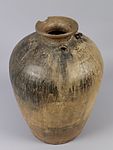Jar
About this object
History of use
Probably exported from Thailand to the Philippines via the Burmese port of Martaban from which the generic name for large jars is derived. These pot-bellied jars were designed for long journeys at sea, with lugs big enough to pass a rope through and as containers for food, oil and water as well as for packing smaller porcelains. They are also referred to as dragon jars because they often, though not in this case, have a moulded dragon decoration on their sides. While dragon jars were mainly manufactured in the kilns of southern China as trade items during the song and Ming dynasties, they were also manufactured in other parts of Southeast Asia such as Burma, Cambodia, Thailand and Vietnam and are still being manufactured today in parts of Asia. This jar was probably produced in the Kalong kiln complex of northern Thailand which was active throughout the late 13th to mid-16th centuries. Due to their physical characteristics - resonance, vitreosity and durability - ceramics became fully integrated with the ideology and ritual in Philippine societies and played an important role in all aspects of cultural life (Langrick, p.61). Their functions were varied and included utilitarian, ceremonial, religious roles, as heirlooms, in mortuary ceremonies as burial goods and as items of prestige. Treasured for their supernatural powers, large jars were considered to harbour spirits or household gods while some spoke prophesying events. As mortuary objects ensuring adequate protection of the departed soul, large jars have been found as grave goods, in inhumation burials where bodily remains are encased and in cremation burials where ashes of the dead are placed.
Narrative
Excavated at a burial site in Barrio Bayan, town of Puerto Galera, Mindoro Province, Philippines.
Cultural context
exchange; status; ceremonial; mortuary
Iconographic meaning
In many indigenous groups of the Philippines, supernatural power was attributed to Chinese ceramics because of the ringing sound emitted when lightly taped and their impermeable quality. The ringing sound was seen as a magical voice able to attract the attention of powerful ancestor spirits. Their impermeable and seemingly imperishable surfaces were believed to have great protective power against all kinds of influences, from evil spirits to poisons (Langrick, p. 55-56). It is likely that Kalong ceramic wares were also associated with these qualities. According to Langrick, the country of origin of these wares were not important and distinctions were not made between Chinese, Sawankhalok (Thai), Annamese (Vietnamese), Cambodian or native pottery. Whatever distinctions were made concerned only their actual serviceability for the ritual being performed (p. 258).
Specific techniques
Date Made
1299-1500
Date Acquired
16 Nov 1987
How Acquired
Donated
Credit Line
Measurements
Overall: 55.6 cm x 41.5 cm
Object Number
Ia254
